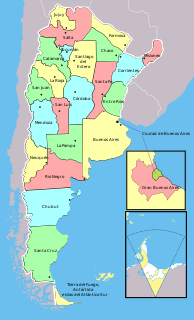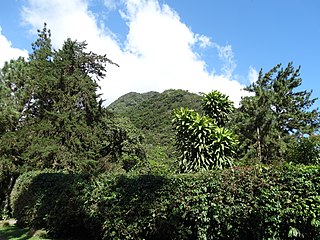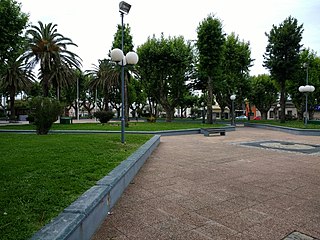
Argentina is subdivided into twenty-three provinces and the autonomous city of Buenos Aires, which is the federal capital of the nation as decided by the Argentine Congress. The provinces and the capital have their own constitutions, and exist under a federal system.

La Plata is the capital city of Buenos Aires Province, Argentina. According to the 2010 census [INDEC], it has a population of 654,324 and its metropolitan area, the Greater La Plata, has 787,294 inhabitants. It is located 6 miles (9 km) inland from the southern shore of the Río de la Plata estuary.

Coclé is a province of central Panama on the nation's southern coast. The administrative capital is the city of Penonomé. This province was created by the Act of September 12, 1855 with the title of Department of Coclé during the presidency of Dr. Justo de Arosemena. It became a province, Decretory Number 190, on October 20, 1985. Coclé is primarily an agricultural area, with sugar and tomatoes as major crops. The province has a number of well-known beaches, such as Santa Clara, Farallon and Rio Hato, and tourist activity has increased in recent years. It covers an area of 4,946.6 sq.km, and had a population of 265,149 in 2019.

Greater Buenos Aires, also known as the Buenos Aires Metropolitan Area, refers to the urban agglomeration comprising the Autonomous City of Buenos Aires and the adjacent 24 partidos (districts) in the Province of Buenos Aires. Thus, it does not constitute a single administrative unit. The conurbation spreads south, west and north of Buenos Aires city. To the east, the River Plate serves as a natural boundary.

This is a list of the 50 largest cities in the Americas by population residing within city limits as of 2015, the most recent year for which official population census results, estimates or short-term projections are available for most of these cities. These figures do not reflect the population of the urban agglomeration or metropolitan area which typically do not coincide with the administrative boundaries of the city. For a list of the latter, see List of metropolitan areas in the Americas by population. These figures refer to mid-2015 populations with the following exceptions:
- Mexican cities, whose figures derive from the 2015 Intercensal Survey conducted by INEGI with a reference date of 15 March 2015;
- Calgary, whose 2015 municipal census had a reference date of April 1.
- Brazilian Cities, whose figures originate from the 2021 estimate given by the IBGE, with a reference date of July 1st, 2021.

San Carlos is a city in the Maldonado Department of southern Uruguay. "San Carlos" is also the name of the municipality to which the city belongs. The municipality includes the following zones: San Carlos, El Tesoro, La Barra, Edén Rock, El Chorro, Manantiales, Balneario Buenos Aires, Punta Piedras, Santa Mónica, San Vicente, El Edén, Paso de la Cantera, Las Cañas, Carapé, Mataojo, Guardia Vieja, Pago de la Paja, Partido Norte, Partido Oeste, Cañada Bellaca, Corte de la Leña, Punta del Campanera, Puntas de Mataojo, and Laguna José Ignacio.
Toledo is a small city in the Canelones Department of Uruguay. Together with Villa Crespo y San Andrés, it forms a population centre of more than 14,000, which is also generally known as "Toledo", although the censual area of Toledo itself has only about 4,400 inhabitants, according to the 2011 census. They are both part of the wider metropitan area of Montevideo.
La Paz is a small city in the Canelones Department, southern Uruguay.
Ciudad del Plata is a city in San José Department of Uruguay.
Buenos Aires is a district of the Buenos Aires canton, in the Puntarenas province of Costa Rica.
Venecia is a district of the San Carlos canton, in the Alajuela province of Costa Rica.
Buenos Aires is a district of the Palmares canton, in the Alajuela province of Costa Rica.
La Granja is a district of the Palmares canton, in the Alajuela province of Costa Rica.
Pilas is a district of the Buenos Aires canton, in the Puntarenas province of Costa Rica.
Colinas is a district of the Buenos Aires canton, in the Puntarenas province of Costa Rica.
Pacuarito is a district of the Siquirres canton, in the Limón province of Costa Rica.






